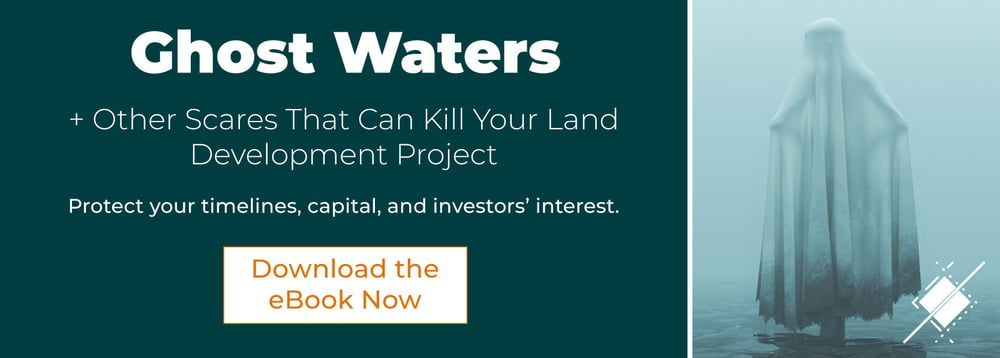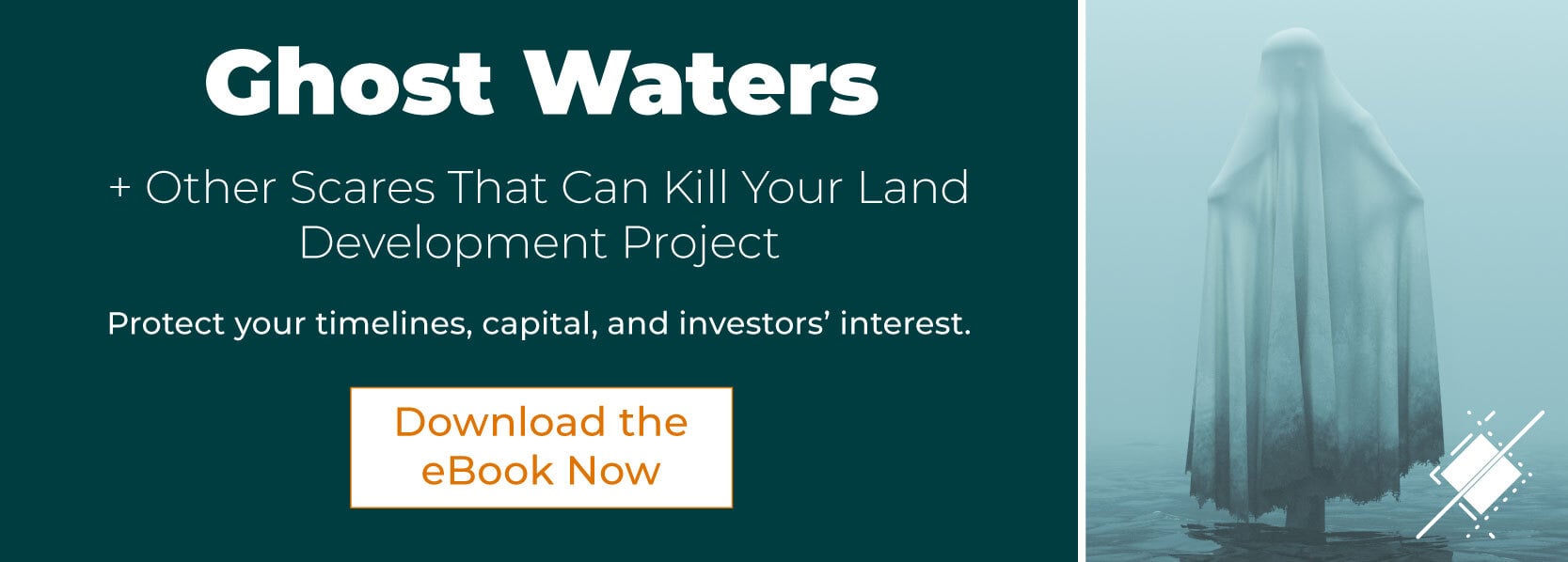3 min read
Ghost Waters and Other Scares That Can Kill Your Land Development
![]() Transect Team
:
Nov 7, 2022
Transect Team
:
Nov 7, 2022
.webp)
Listen to the audio version
You’ve done everything right.
Wooed that landowner. Completed your due diligence. Gotten all the proper permits. You’re on the fast track to Success Town, and ain’t no one going to stop you.
Until it rains.
Don't Let Ghost Waters Get You Down
Sure, rain is natural. A good thing, even. However, when it comes to developing a site for green energy – whether we’re talking solar, wind, or another approach – rain is something you’ve got to watch out for. Not because of the rain itself but rather because of the permit-defying effects it can have on your land.
Why? Ghost waters, friend.
WooooOOOOOOOooooo ….
What are ghost waters, exactly? The long answer is a collection of water bodies that aren’t well defined in United States law and whose regulatory implications are ever-changing. Thanks, Clean Water Act.
Seriously, it’s a Whole Thing.
The short answer is that ghost waters are streams, wetlands, floodplains, tributaries, ditches, hydric soils, and other areas that are dry much of the year but collect water during precipitation events or snowmelt, which can drastically alter the ecological implications of any given piece of land.
If that sounds slightly worrying, then you’ve been paying attention.
If you want to ensure your projects stay on track, you’ve got to know about this crucial issue. Our latest eBook, “Ghost Waters and Other Scares That Can Kill Your Land Development,” will help you understand the definition of and risks posed by ghost waters so that you can make an intelligent decision regarding your site from the get-go.
Sound good? Get it now.
The Challenges Posed by Ghostly Waterways
The tricky thing about ghost waters is how transitory they can be. Some streams or wetlands are only present for a few days (or less) following rain. In the between-times, it is hard to impossible to tell they’re even there. They leave little evidence of their passing, and most of the time, no one has recorded them in the pertinent hydrology literature.
Many folks wonder why, if that’s the case, we need to worry about them at all. Are they really an issue if they only pop up every couple of months – or every few years?
The answer is a hard yes because even short-lived streams can still affect water quality by moving debris and sediment into other waterways and groundwater. This can have adverse impacts on aquatic organisms and contaminate drinking water, harming human health. Moreover, many ephemeral streams (also known as headwater streams) ultimately become some of the greatest river systems on Earth – and those systems are, in turn, dependent on the smallest beginnings. For this reason, ephemeral streams are one of our most critical natural resources.
This means we cannot ignore those beginnings in the environmental development process.
Doing so leads to numerous hazards and potential impacts, including:
-
Accidentally building on land that isn’t appropriate
-
Disrupting watershed ecosystems or reservoirs downstream of your site
-
Realizing halfway through development that your project is a no-go
-
Getting dinged (or seriously penalized) for failing to meet federal or other regulations
-
Losing the trust of partners or investors
-
Adding a large concentration of contaminants to freshwater aquatic habitats
For obvious reasons, these are all Very Not Great Outcomes. If you, like any other sane person, want to avoid them, it’s time for a crash course in ghost waters and what they mean for you.
We’ve Got an eBook for That
In it, you’ll learn:
-
The difference between perennial, intermittent, and ephemeral streams
-
Why this difference matters
-
How protections have changed over time and why that matters too
-
How to determine whether the site you’re considering has any ghost waters present
-
The risks of ghost waters on your site and the environmental impact of developing there
-
Which hacks can you use to prevent ghost waters and other water resources from damaging your project
-
What other project risk factors you need to be aware of … and mitigation strategies to get around them
-
Why the current due diligence systems don’t work
-
What to do instead
Think one little download can’t hold all the answers? Well, you’re right. For instance, we don’t teach you how to get out of that engagement party with your old college roommate or make the perfect homemade pizza. Some questions are just too big for us.
However, we've got it all when it comes to ghost waters and other risks that might derail your green energy project. And you can too … just click that image below.
Speaking of Other Risk Factors That Derail Renewable Energy Development …
Ghost waters, while inarguably the risk factor with the coolest title, are far from the only one you need to worry about. Unfortunately, there are all kinds of spooky specters with adverse effects waiting to get in the way of your happiness, profits, and ability to stave off climate change.
Others to watch out for include:
-
NIMBY
-
Hostility toward solar and wind projects
-
Environmental consulting issues
-
Delays to interconnect
-
Changes in regulations
-
Misunderstanding of regulations
Considering that only 10 percent of sites get developed when it comes to solar (with similar numbers for other types of energy), you can’t be too careful when finding a spot you like. It’s so important to get out ahead of these issues, and the only way to do that is to understand what you’re up against.
Which is, in a phrase, a lot.
The good news? There’s one system that can solve all these problems AT THE SAME TIME, and we’ll tell you all about it in the eBook. So don’t wait a minute longer to find out.



